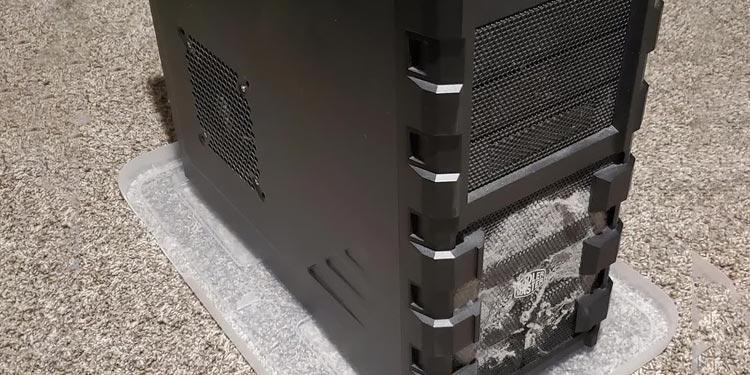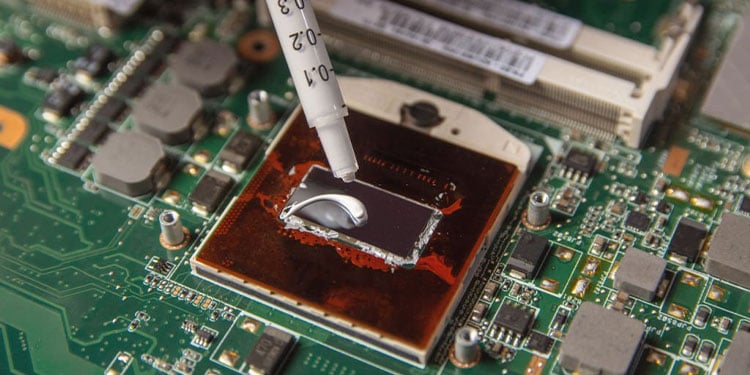What is a Heatsink?
A heatsink is the part of a device designed to move heat away from the hottest areas on that device. For example, on a GPU, the heatsink helps move the heat away from the GPU chip that powers the card.Heatsinks work by increasing the surface area near the hot places on computer parts. Increased surface area helps move the heat away from the part generating it and to cooler parts, where the fans can help move the hot air out of the computer. The heatsink moves the heat away using conduction, which is a crucial aspect of your computer’s cooling system.Conduction happens when heat moves through a solid object, like the metal of the heatsink. It’s a kind of passive cooling device because it doesn’t do anything to achieve this other than exist. Different types of active cooling, like fans and water loops, can help the heatsinks more quickly get rid of the hot air and cool the inside of your computer. Computer components get hot fast, especially when they’re under heavy load. Just turning on a high-end game with the graphics turned up can cause it to jump ten degrees or more in under a minute. That’s why efficient, adequate cooling is so necessary for your PC.
What Parts Have Heatsinks?
Most parts in your PC have heatsinks. Your motherboard and GPU will have passive cooling to help move the high heat the chips in the CPU and GPU generate away. However, you’re likely going to see smaller heatsinks on many parts if you open your computer and take a look. They aren’t all as dramatic as the deep grills on some devices. Sometimes heatsinks just look like a small metallic honeycomb designed to move heat away and introduce cooler air.
What Are Heatsinks Made of?
Heatsinks are usually made of metal. However, different manufacturers may choose to use different kinds of metal, which can affect how well the heatsink performs. You’re most likely to see aluminum and copper in modern heatsinks.Aluminum is more likely to be used on lower-end parts because it’s less expensive and lighter. Heatsinks add significant weight to the components to which they’re attached. Using aluminum means manufacturers don’t have to account for the extra weight with their designs by bracing them or supporting them. Its thermal conductivity is less than 250 Water per meter per degree Kelvin.Copper is found more often in high-end components. With a thermal conductivity of around 400, it’s significantly better at moving heat than aluminum. However, it is also heavier and more expensive. There are also heatsinks made of multiple materials. Coating an aluminum heatsink with copper can make it move heat more effectively than aluminum alone without adding the cost and weight of pure copper. Some materials conduct heat much better than copper or aluminum. However, despite its thermal conductivity being over 2000, I have yet to see a heatsink made entirely from diamond.
How Can I Make My Heatsink More Effective?
Your heatsink is only part of the cooling system in your computer. Supporting it with active cooling, adequate space, and keeping it clean will help it work more efficiently.
Active Cooling
You must supplement the passive cooling of the heatsink with active cooling throughout the case. It’s necessary to ensure your temperatures stay low enough to keep your components in good condition. There are two major types of active cooling to consider:
Air cooling uses fans to pull air through the case, displacing hot air with cooler air from outside. The position of the fans is critical, as you don’t want to just blow hot air around in the case. Also, many parts come with their own built-in fans to help add to the cooling of the case fans you install.
Water cooling uses water in sealed tubes to move heat away from components like the CPU and GPU. While many cases exist that use only air cooling, you shouldn’t only use water cooling. It is designed to help lower the heat at specific parts and should be part of a system that includes passive cooling and fans.
Having enough extra cooling is the best thing you can do to keep the heatsinks doing their jobs properly. The other cooling methods will take heat away from the heatsinks, making cooler areas for newly generated heat to move into. Some heatsinks come with fans or blowers of their own, designed to move the hot air away specifically from that heatsinks. You might see these referred to as an active heatsinks. They can be more effective than standard heatsinks.
Space Inside the Computer Tower
While small builds are great for certain circumstances, consider that you want some empty space in your computer tower. Open space gives you more room between components and more air for the heat to dissipate into. When parts that generate heat operate practically on each other, they warm each other up and make it more difficult for the passive heatsinks to do their work. For example, a GPU operating almost on top of your motherboard may even have its fans directing the hot air away from the GPU to the motherboard.When you position your components like this, they add to each other’s heat rather than remove it. You want enough space to have room for airflow.
The Position of Your Computer
The position of your computer also contributes to how well your heatsinks work. The more airflow, the better they work. Don’t leave your computer on the carpet. Have some space under the tower that the air can move through – even if it means having to prop it on top of a hard, flat surface. Leave enough room at the edges so it isn’t touching a wall, which removes an entire side where it could be getting air.When choosing a case, look for one with legs and vents. You’ll be able to get more cool air into the case to support the heatsinks this way.
Keeping Your Heatsinks Clean
The cleaner your heatsinks are, the more able they are to release the heat. Over time, dust builds up on your PC components and can keep them from working as well as they would when clean. Take a can of compressed air and blow dust away from every heatsink in your computer when you notice it gathering. Doing so will help them keep your computer cooler.
Keep Your Thermal Paste in Good Condition
Heatsinks also use a grease called thermal paste as part of their cooling solution. This grease moves heat from the element generating the heat to the heatsink more effectively than it would with direct contact.Thermal paste stays good for years in most cases but should be changed when it’s reaching the end of its life. If your temperatures are beginning to creep up on the CPU or GPU, consider taking it apart to add the new thermal paste. It might increase the effectiveness of your heatsink and lower your operating temperatures.










